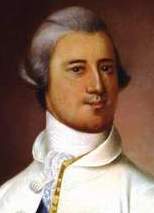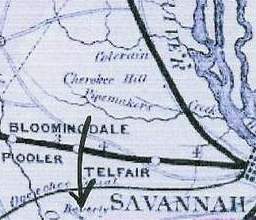James Habersham of Silk Hope, Dean Forest and Beverly Plantations
 James Habersham arrived in Savannah with his friend, George Whitefield, on May 7, 1738. The
gentlemen were surprised at the rapid death rate and the number of children left
destitute, so rented an empty house, hired a housekeeper, and gathered up the orphans. Rev.
Whitefield later opened Bethesda Orphans Home in Savannah, and James Habersham married one
of the older orphan girls, Mary Bolton. From 1750 to 1775, James Habersham was one of the largest rice planters in Georgia, also
establishing a commercial house. Silk Hope had 3,423 acres of land on the Little Ogeechee River.
During the early 1740s Habersham formed a business association with Francis Harris of Savannah to begin shuttling supplies from Charleston to Savannah and Bethesda. As the Trustees' grip on colonial Georgia loosened, Habersham and Harris set up a firm in Savannah to begin making regular transatlantic commercial voyages to England. Their firm is recognized as the first such successful business enterprise in colonial Georgia.
With resources from his business, Habersham began acquiring lands for rice planting along rivers near Savannah. Once the ban on slavery ended in Georgia, Habersham developed extensive rice plantations on holdings eventually totaling nearly 15,000 acres, worked by about 200 slaves. By the 1750s he had begun to become politically prominent as well, as a senior councillor in the royal government of the colony. He also served as council president and held the position of acting governor of Georgia in the early 1770s.
All three of Habersham's sons became actively involved in the Revolutionary movement. Joseph Habersham, in particular, became a zealous revolutionary in 1774, although his aging father expressed his own loyalty to Britain. The senior Habersham's death in 1775 prevented the painful family division from extending into the war years.
James Habersham arrived in Savannah with his friend, George Whitefield, on May 7, 1738. The
gentlemen were surprised at the rapid death rate and the number of children left
destitute, so rented an empty house, hired a housekeeper, and gathered up the orphans. Rev.
Whitefield later opened Bethesda Orphans Home in Savannah, and James Habersham married one
of the older orphan girls, Mary Bolton. From 1750 to 1775, James Habersham was one of the largest rice planters in Georgia, also
establishing a commercial house. Silk Hope had 3,423 acres of land on the Little Ogeechee River.
During the early 1740s Habersham formed a business association with Francis Harris of Savannah to begin shuttling supplies from Charleston to Savannah and Bethesda. As the Trustees' grip on colonial Georgia loosened, Habersham and Harris set up a firm in Savannah to begin making regular transatlantic commercial voyages to England. Their firm is recognized as the first such successful business enterprise in colonial Georgia.
With resources from his business, Habersham began acquiring lands for rice planting along rivers near Savannah. Once the ban on slavery ended in Georgia, Habersham developed extensive rice plantations on holdings eventually totaling nearly 15,000 acres, worked by about 200 slaves. By the 1750s he had begun to become politically prominent as well, as a senior councillor in the royal government of the colony. He also served as council president and held the position of acting governor of Georgia in the early 1770s.
All three of Habersham's sons became actively involved in the Revolutionary movement. Joseph Habersham, in particular, became a zealous revolutionary in 1774, although his aging father expressed his own loyalty to Britain. The senior Habersham's death in 1775 prevented the painful family division from extending into the war years.
During those years Joseph and his younger brother, John, pursued careers in the Continental army that eclipsed the career of their elder brother, James Jr., who remained satisfied with political and financial involvement in the Revolution. Joseph rose to the rank of colonel but resigned Continental army service during the war. His resignation stemmed partly from his involvement in the notorious McIntosh-Gwinnett duel and partly from his desire to enter state politics as a moderate opposed to the liberty faction of Midway and Sunbury. John continued his career in the Continental army, rising to the rank of major. He was twice captured (at the fall of Savannah and the fall of Charleston, South Carolina) and twice exchanged in active service throughout the war. At war's end the Habersham brothers concentrated on restoring family plantations known as Dean Forrest, Silk Hope, and Beverly. Though involved in commerce on the eve of the Revolution, they did not reenter business. All three engaged in postwar politics as members of the Georgia Assembly. Joseph and John also were appointed to the Confederation Congress in the 1780s. The brothers actively supported the adoption of the constitution in 1788. Silk Hope was acquored in 1761 from William Butler. Silk Hope later became part of Richmond Hill

Site of Beverly Plantation
When James Habersham died in 1775 in Savannah, he left another plantation Dean Forest to his son, John. Also, he bequeathed his other sons large tracts of land located on the south side of the Great Ogeechee River. He was buried in the Colonial Cemetery in Savannah.

